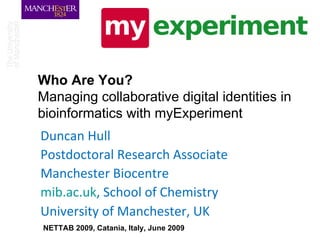myExperiment @ Nettab
Digital Identity is fundamental to collaboration in bioinformatics research and development because it enables attribution, contribution, publication to be recorded and quantified. However, current models of identity are often obsolete and have problems capturing both small contributions "microattribution" and large contributions "mega-attribution" in Science. Without adequate identity mechanisms, the incentive for collaboration can be reduced, and the utility of collaborative social tools hindered. Using examples of metabolic pathway analysis with the taverna workbench and myexperiment.org, this talk will illustrate problems and solutions to identifying scientists accurately and effectively in collaborative bioinformatics networks on the Web.

Recomendados
Recomendados
Más contenido relacionado
La actualidad más candente
La actualidad más candente (20)
Destacado
Destacado (6)
Similar a myExperiment @ Nettab
Similar a myExperiment @ Nettab (20)
Más de Duncan Hull
Más de Duncan Hull (18)
Último
Último (20)
myExperiment @ Nettab
- 1. Who Are You? Managing collaborative digital identities in bioinformatics with myExperiment Duncan Hull Postdoctoral Research Associate Manchester Biocentre mib.ac.uk , School of Chemistry University of Manchester, UK NETTAB 2009, Catania, Italy, June 2009
- 5. Galileo Galilei (1632) Dialogo sopra i due massimi sistemi del mondo
- 11. Digital attribution Neil Smalheiser and Vetle Torvik Attribution would seem to be a simple process and yet it represents a major, unsolved problem for information science. Author name disambiguation Chapter published in Volume 43 (2009) of the Annual Review of Information Science and Technology (ARIST) (edited by B. Cronin) which is available from the publisher Information Today, Inc http://www.hbs.edu/units/tom/seminars/2007/docs/Author%20Name%20Disambiguation.pdf
- 17. Taverna Trident BioExtract Kepler Triana BPEL Ptolemy II
- 19. http://openid.net/ Tackling Digital Identity and attribution
- 21. But you can’t force OpenID on people…(yet) http://romano.myopenid.com/ [email_address] nettab OR Password handled by third party OpenID provider + 84% 16%
- 26. HTML For Developers mySQL Search Engine reviews ratings groups friendships tags Enactor files workflows ` RDF Store SPARQL endpoint Managed REST API facebook iGoogle android XML API config profiles packs credits
- 27. PREFIX rdf: <http://www.w3.org/1999/02/22-rdf-syntax-ns#> PREFIX myexp: <http://rdf.myexperiment.org/ontology#> PREFIX sioc: <http://rdfs.org/sioc/ns#> select ?friend1 ?friend2 ?acceptedat where {?z rdf:type <http://rdf.myexperiment.org/ontology#Friendship> . ?z myexp:has-requester ?x . ?x sioc:name ?friend1 . ?z myexp:has-accepter ?y . ?y sioc:name ?friend2 . ?z myexp:accepted-at ?acceptedat } All accepted Friendships including accepted-at time Semantically-Interlinked Online Communities SPARQL endpoint: maximises data re-use
- 29. R epresenting E vidence F or I nteracting N etwork E lements
- 30. http://www.biomodels.net http://www.sbml.org http://pubmed.gov Case Study REFINE Project: Improving SBML models Metabolic reconstruction Difficult Document level “tools and resources” - fairly straightforward
- 31. Example from Glycolysis in Yeast reactant reactant product product modifier This is just one reaction, there are at least another 1700+ in Yeast
- 35. Conclusions: Aristocracy 2.0 or Democracy 2.0? What will Science 2.0 look like once scientists start sharing more data on the web? We live in exciting times! High barrier to entry, exclusive Low barrier to entry, inclusive Artistocratic ? (program committees, editorial boards, funding panels, academic faculty staff etc) Democratic (“a link is a vote”) and Technocratic (“The geeks shall inherit the earth”) Heavily filtered information (peer review) Lightly filtered information (or not filtered at all) Wisdom of experts Wisdom of Crowds Science 1.0 ? Web 2.0
- 36. Conclusions: Participation Inequality: http://www.useit.com/alertbox/participation_inequality.html Dr. Jakob Nielsen 90% of users in online communities are “lurkers” who never contribute
